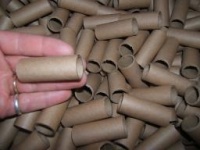Paper tubes
From PyroGuide
|
Almost any pyrotechnic device is made using cylindrical paper tubes. Rockets, lances, shells, fountains, mortars, etc. Tubes can be found or bought, but sometimes it is better to roll your own tubes. There are two types of cylindrical paper tubes: spiral wound and parallel/convolute wound. The parallel wound is generally stronger than the spiral wound, since it is rolled of one continuous piece of paper rolled orthogonal to the dowel.
|
[edit] MaterialsPaper Glue Dowel Other
|
[edit] ConstructionPlace a sheet of paper on a hard, flat surface (e.g. table, desk, etc.). Cut it into strips as wide and as long as you want the casings to be. The length of a strip will determine the wall thickness of the casings (if necessary, more strips can be used to obtain casings with thicker walls). Place one strip in front of you, and tape the far end to the working surface.
|
|
Place the dowel of the required diameter on the strip of paper, perpendicular to the strip.
|
|
To start, apply glue to the first edge of paper and roll it tightly around the dowel. Pay extra attention to the edges of the paper when applying glue. Press the dowel against the table and pull it towards you to prevent the paper from wrinkling. Also a good way to increase the hardness of the paper is to wet the paper before applying the glue and spread it with a brush, water helps the glue seep into the pores of the paper.
|
|
Now, apply glue to the whole strip of paper. Again, make sure all the edges are well covered. Spread the glue evenly over the paper.
|
|
Start rolling. Pull the dowel towards you to prevent wrinkling.
|
|
You will most likely find that the dowel was not perfectly aligned with the paper and starts moving sideways as you roll. This can be corrected for to a certain extend by pulling more on one side of the dowel. However, it is better to avoid this as it will make the casings slightly less tight and strong. It takes some practice to master the technique well.
|
|
When the end of the paper is reached, cut the paper parallel to the tape with a sharp knife, and apply glue to the edges. Roll the last stretch of paper onto the dowel.
|
|
Trim the ends of the tube with a sharp knife and lay the tube aside to dry. [edit] SourceWouter's Practical Pyrotechnics -> Device components -> Paper tubes |

